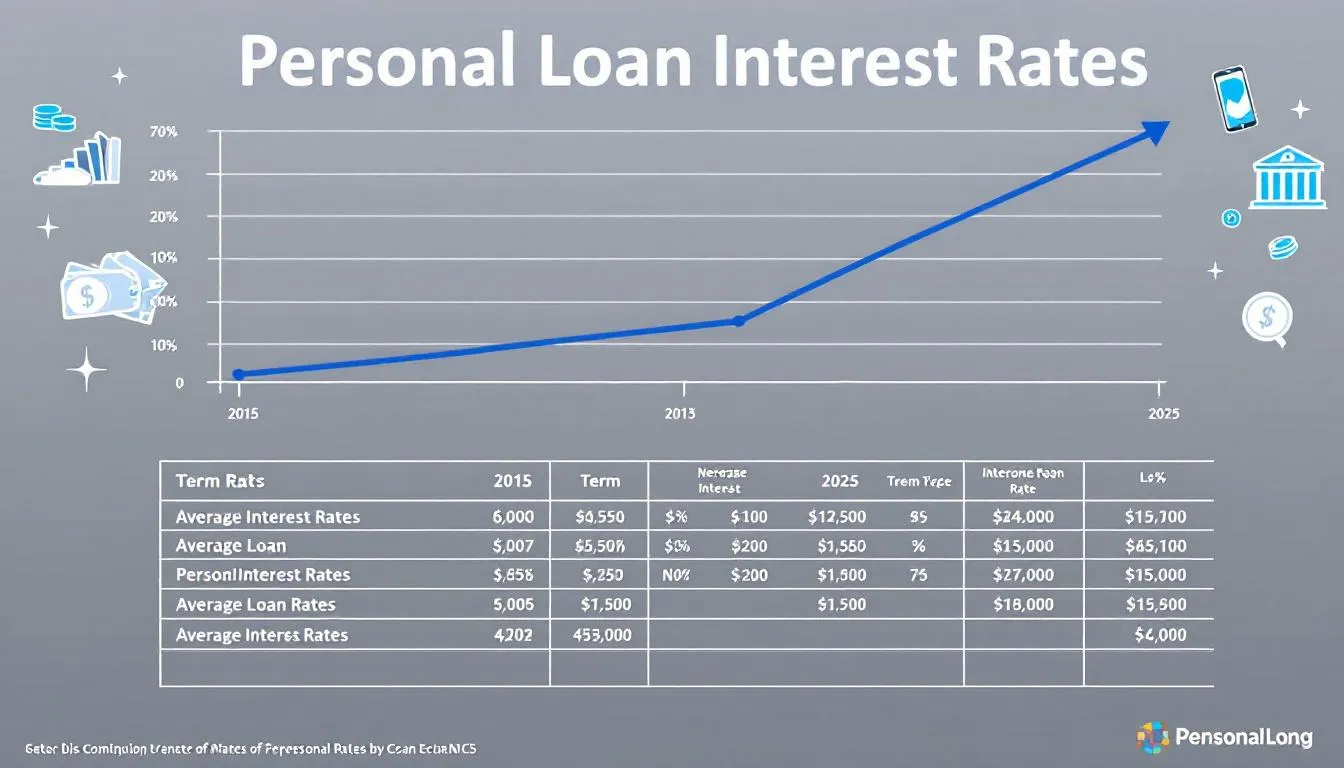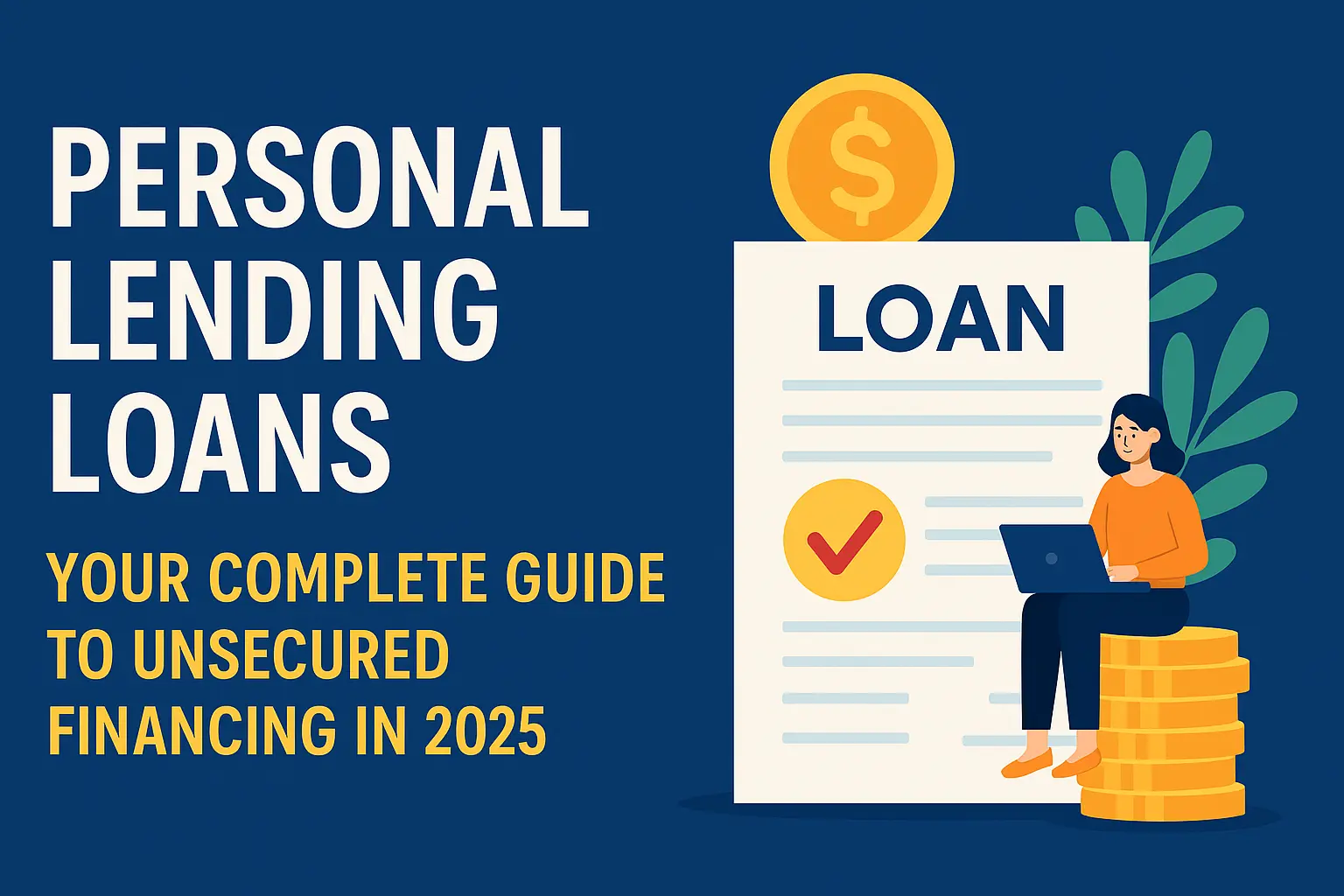
The personal lending market in India has witnessed explosive growth, with digital disbursals expected to dominate traditional channels by 2026. As consumers increasingly seek flexible financing solutions without the hassle of collateral requirements, personal lending loans have emerged as the go-to option for addressing diverse financial needs.
Whether you’re facing a medical emergency, planning a wedding, or looking to consolidate existing debts, understanding the intricacies of personal loans can save you thousands of rupees and streamline your borrowing experience. This comprehensive guide will walk you through everything you need to know about personal lending loans, from basic definitions to advanced strategies for securing the best possible terms.
Key Takeaways
- Personal lending loans are unsecured loans ranging from ₹20,000 to ₹75 lakh with no collateral required
- Interest rates typically range from 8% to 31% per annum based on credit score and lender policies
- Loan tenures extend from 12 months to 96 months with flexible EMI options
- CIBIL score of 720+ significantly improves approval chances and reduces interest rates
- Instant approval and same-day disbursal available for pre-approved customers
- Processing fees range from 1% to 5% of loan amount with some lenders offering zero foreclosure charges
What Are Personal Lending Loans?
Personal lending loans represent a form of unsecured credit product extended by banks, non-banking financial companies (NBFCs), credit unions, and increasingly popular online-only lending platforms. The term “unsecured” is crucial here – it means you don’t need to pledge any collateral such as property, fixed deposits, or other valuable assets against the loan amount.
This fundamental characteristic makes personal loans accessible to a broader segment of borrowers who may not own significant assets but have stable income and good creditworthiness. The approval process relies primarily on your credit score, verified income, and employment stability rather than asset ownership.
Multipurpose Financial Solution
One of the most attractive features of personal loans is their versatility. Unlike specialized loans such as home loans or car loans that restrict fund usage, a personal loan online application allows you to use the money for virtually any lawful purpose:
- Medical emergencies and unexpected healthcare expenses
- Wedding celebrations and associated costs
- Education expenses including professional courses
- Home renovation and improvement projects
- Travel and vacation funding
- Debt consolidation to simplify multiple payments
- Business startup costs or equipment purchases
Key Benefits Over Other Credit Options
When you get a personal loan, you’re accessing several advantages that make it superior to alternatives like credit cards or informal lending:
No Collateral Risk: Unlike secured loans, you don’t risk losing your home or other assets if you face repayment difficulties.
Fixed Repayment Structure: Personal loans offer predictable fixed monthly instalments, making budget planning easier compared to revolving credit facilities.
Lower Interest Than Credit Cards: Personal loan interest rates are typically lower than credit card interest rates, especially for borrowers with good credit scores.
Quick Access to Large Amounts: You can access substantial funds quickly, often within 24 hours for pre-approved customers.
Types of Personal Lending Loans

Understanding the various types of personal loans available helps you choose the product that best matches your specific needs and repayment preferences.
Term Loans
Traditional term loans form the backbone of personal lending, featuring a straightforward structure with fixed principal, interest rate, and repayment tenure. When you apply for a personal loan of this type, you receive the entire approved loan amount upfront and repay it through fixed monthly instalments over the predetermined period.
These loans work well for one-time expenses like medical bills, wedding costs, or home renovations where you need the full amount immediately and prefer predictable monthly payments.
Flexi Term Loans
Flexi term loans offer a credit line approach, providing more flexibility in how you access and repay funds. Instead of receiving the entire loan amount upfront, you get an approved credit limit from which you can withdraw funds as needed.
The key advantage is that you pay interest only on the amount you actually use, not the entire sanctioned limit. This makes flexi loans ideal for ongoing expenses or situations where you’re unsure about the exact amount needed.
Flexi Hybrid Term Loans
These innovative products combine features of both fixed-term loans and overdraft facilities. You can make partial withdrawals, prepayments, or even temporary repayments during the loan tenure, offering maximum flexibility for borrowers with irregular income patterns or varying cash flow needs.
Instant Personal Loans
The digital revolution has made instant personal loan online applications a reality. These are typically pre-approved loans offered to existing customers with good credit history and banking relationships. The approval and disbursal can happen within minutes, making them perfect for urgent financial needs.
Banks leverage existing customer data, transaction history, and automated risk assessment to provide these quick approvals without extensive documentation.
Personal Loan Balance Transfer
If you have an existing personal loan with high interest rates, a personal loan balance transfer allows you to move your outstanding loan amount to a new lender offering better terms. This can result in significant interest savings, lower EMIs, or both, depending on the new loan terms you negotiate.
Interest Rates and Charges
Understanding the complete cost structure of personal loans helps you make informed borrowing decisions and avoid unpleasant surprises during the loan tenure.
Interest Rate Dynamics

Personal loan interest rates in India span a wide range from 10% to 31% per annum, with your specific rate determined by several factors:
Credit Score Impact: Borrowers with excellent credit scores (750+) typically qualify for the lowest rates around 10%-15%, while those with fair credit (600-700) may face rates of 15-25%.
Income and Employment Stability: Higher income levels and stable employment with reputed organizations often translate to better interest rates.
Existing Banking Relationship: Long-standing customers with good transaction history may receive preferential pricing.
Loan Amount and Tenure: Larger loan amounts and shorter tenures sometimes qualify for better rates due to lower risk perception.
Most lenders use the reducing balance method for interest calculation, meaning you pay interest only on the outstanding principal amount. This provides transparency and ensures you’re not paying interest on already repaid portions.
Processing Fees and Additional Charges
Beyond the personal loan interest rate, several other charges impact your total borrowing cost:
Processing Fee: Typically ranges from 1% to 5% of the loan amount, though some lenders offer zero processing fee promotions. This fee covers administrative costs for loan processing and documentation.
Documentation Charges: Some lenders charge separately for document verification, legal checks, and administrative processing.
Stamp Duty: Required for loan agreements, especially for larger amounts, varying by state regulations.
Late Payment Penalties: Applied when you miss EMI due dates, usually ranging from ₹500 to ₹1,500 per occurrence.
Prepayment Charges: While many lenders now offer zero foreclosure charges as a competitive advantage, others may charge 2-5% of the outstanding amount for early loan closure.
When comparing offers, focus on the Annual Percentage Rate (APR) which includes both interest and mandatory fees, providing a more accurate cost comparison.
Eligibility Criteria and Documentation
Meeting personal loan eligibility criteria is the first step toward securing financing, and understanding these requirements helps you prepare a strong application.
Age and Employment Requirements
Age Criteria: Most lenders accept applications from individuals aged 21-65 years for salaried employees and up to 70 years for self employed professionals.
Employment Stability: Lenders typically require:
- Minimum 2-3 years of total work experience
- At least 1 year with the current employer for salaried individuals
- Stable business operations for at least 2-3 years for self-employed applicants
Income Thresholds: Minimum monthly income requirements usually range from ₹15,000 to ₹30,000, depending on the lender and your city of residence. Metro cities often have higher income requirements due to cost of living considerations.
Credit Score Requirements
Your CIBIL score plays a crucial role in loan approval and interest rate determination. Here’s how different score ranges typically fare:
750+: Excellent chance of approval with the most competitive interest rates 700-749: Good approval prospects with attractive rates 650-699: Moderate approval chances, may face higher interest rates 600-649: Limited options, significantly higher interest rates Below 600: Very challenging to secure approval from mainstream lenders
Income Documentation Requirements
For Salaried Individuals:
- Last 3 months’ salary slips
- Bank statements for the past 3-6 months showing salary credits
- Form 16 or Income Tax Returns for the previous 2 years
- Employment certificate or appointment letter
For Self-Employed Professionals:
- Income Tax Returns for the past 2-3 years
- Audited financial statements (if applicable)
- Bank statements for the past 6-12 months
- Business registration documents
- Professional qualification certificates (for doctors, CAs, etc.)
Debt-to-Income Ratio
Lenders carefully evaluate your debt-to-income ratio to ensure you can comfortably handle additional EMI obligations. Ideally, your total EMI commitments (including the new personal loan) should not exceed 50-55% of your net monthly income.
Loan Amount and Tenure Options
Personal lending loans offer considerable flexibility in both amount and repayment timeline, allowing you to customize the loan to your specific financial situation.
Loan Amount Determination
Minimum Amounts: Most lenders start personal loan offerings from ₹20,000 to ₹50,000, making them accessible for smaller financial needs.
Maximum Limits: High-income borrowers with excellent credit can access up to ₹75 lakh, though typical loans for middle-income borrowers range from ₹2-10 lakh.
Income Multiple Method: Lenders typically use a multiplier of 10-25 times your net monthly income to determine your maximum personal loan amount eligibility. For example, if you earn ₹50,000 monthly, you might qualify for loans up to ₹10-12.5 lakh.
Existing Obligations Impact: Your current EMI commitments reduce available loan amount since lenders maintain strict debt-to-income ratios.
Repayment Tenure Flexibility
Personal loans offer repayment tenure options ranging from 12 to 96 months, allowing you to balance between EMI affordability and total interest cost:
Shorter Tenures (12-24 months): Higher EMIs but lower total interest outgo Medium Tenures (24-48 months): Balanced approach between EMI amount and interest cost Longer Tenures (48-96 months): Lower EMIs but higher total interest cost
Use a personal loan emi calculator to evaluate different tenure options and their impact on your monthly budget and total repayment amount.
Top-up Facilities
Many lenders offer top-up personal loans to existing customers who have maintained good repayment history for at least 6-12 months. These additional loans often come with:
- Simplified application process
- Faster approval and disbursal
- Sometimes better interest rates due to proven repayment capability
Application Process and Approval Timeline
The personal loan application process has become increasingly digital, offering convenience and speed that traditional banking channels couldn’t match.
Digital Application Journey
Step 1: Initial Application Most lenders now offer online personal loan applications through their websites or mobile apps. The process typically begins with:
- Mobile number verification via OTP
- Basic personal and employment information entry
- Desired loan amount and tenure selection
- Initial eligibility check based on provided data
Step 2: Document Upload Modern applications allow you to upload scanned copies or photos of required documents directly through the platform:
- Identity proof (Aadhaar, PAN, passport)
- Address proof (utility bills, rental agreement)
- Income proof (salary slips, bank statements, ITR)
- Employment proof (appointment letter, ID card)
Step 3: Verification Process Lenders employ both automated and manual verification:
- Automated data matching with credit bureaus
- Digital verification of documents
- Sometimes telephonic verification of employment and personal details
- Physical verification for larger loan amounts (in some cases)
Approval Timeline Variations
Instant Approval: Pre approved personal loans for existing customers can be approved and disbursed within minutes, especially for smaller amounts and customers with excellent credit history.
Regular Processing: New customers typically experience 2-7 working days for complete processing, including:
- Document verification: 1-2 days
- Credit assessment: 1-2 days
- Final approval and documentation: 1-2 days
- Fund disbursal: Same day after approval
Factors Affecting Speed:
- Completeness of documentation
- Credit score and financial profile
- Loan amount requested
- Lender’s internal processes
- Holiday periods and weekends
Fund Disbursal Methods
Once approved, most lenders disburse funds directly to your bank account via NEFT, RTGS, or IMPS transfer. Some lenders also offer:
- Cheque disbursal for larger amounts
- Direct payment to vendors (for specific purposes like medical bills)
- Prepaid card loading (less common)
Benefits and Features
Personal lending loans offer numerous advantages that make them an attractive financing option for diverse financial needs.
Unmatched Flexibility
Unlike purpose-specific loans, personal loans provide complete freedom in fund utilization. Whether you’re facing a medical emergency, planning your dream wedding, or looking to consolidate multiple debts, you can use the loan proceeds without restrictions or monitoring from the lender.
This flexibility extends to repayment as well, with most lenders offering flexible repayment options including:
- Part-prepayment facilities to reduce interest burden
- EMI holiday options during financial difficulties (subject to lender policies)
- Tenure modification in some cases
Speed and Convenience
The digital transformation of personal lending has made accessing funds incredibly fast:
Quick Processing: From application to disbursal in as little as 24 hours for eligible borrowers Minimal Documentation: Significantly reduced paperwork compared to secured loans Online Management: Complete loan management through mobile apps and internet banking 24/7 Application: Apply anytime, anywhere without visiting bank branches
Competitive Pricing
While personal loan interest rates are higher than secured loans, they offer competitive advantages:
Lower Than Credit Cards: Typically 5-15% lower than credit card interest rates Transparent Pricing: Fixed rates with clear EMI structures, unlike revolving credit facilities Zero Hidden Charges: Reputable lenders clearly disclose all charges upfront
No Collateral Risk
The unsecured nature of personal loans means you’re not risking your home, car, or other valuable assets. This provides peace of mind, especially during uncertain economic times when income stability might be a concern.
Balance Transfer Benefits
If you have an existing personal loan with high interest rates, balance transfer options allow you to:
- Reduce your interest burden significantly
- Lower your monthly EMI obligations
- Potentially access additional funds (top-up) at the time of transfer
Tips for Better Approval Chances
Securing personal loan approval at favorable terms requires strategic preparation and understanding of what lenders value most in borrowers.
Credit Score Optimization
Your credit score is the single most important factor in personal loan approval. Here’s how to optimize it:
Maintain Payment Discipline: Ensure all credit card bills, existing loan EMIs, and utility bills are paid on time. Even a single late payment can impact your score negatively.
Optimize Credit Utilization: Keep your credit card utilization below 30% of available limits. Lower utilization ratios (10-20%) are even better for score improvement.
Maintain Credit Mix: Having a healthy mix of secured and unsecured credit shows responsible credit management.
Avoid Multiple Applications: Each loan application triggers a hard inquiry that temporarily reduces your credit score. Space out applications and use comparison platforms that perform soft checks.
Income and Employment Strategies
Stable Employment: Maintain consistent employment for at least 12-18 months before applying. Frequent job changes raise red flags for lenders.
Document Additional Income: Include income from investments, rental properties, or freelancing work to improve your debt-to-income ratio.
Choose Optimal Timing: Apply when your income is stable and you have recent salary credits in your bank account.
Application Best Practices
Complete Documentation: Submit all required documents in clear, legible format to avoid processing delays.
Accurate Information: Ensure all details in your personal loan application match your supporting documents exactly.
Appropriate Loan Amount: Apply for amounts within 15-20 times your monthly income rather than pushing for maximum eligibility.
Leverage Banking Relationships: Approach banks where you maintain salary accounts or have existing relationships for better consideration.
Debt Management
Clear Existing Debts: Pay off smaller debts before applying to improve your debt-to-income ratio.
Avoid New Credit: Don’t apply for new credit cards or loans in the months leading up to your personal loan application.
Maintain Cash Reserves: Ensure you have emergency funds equivalent to 3-6 months of EMIs to demonstrate repayment capacity.
Repayment and Closure
Understanding the repayment process and closure options helps you manage your personal loan effectively throughout its tenure.
EMI Payment Methods
Auto-Debit Facilities: Set up ECS (Electronic Clearing Service) or NACH (National Automated Clearing House) mandates for automatic EMI deduction. This ensures timely payments and helps maintain your credit score.
Online Payment Options: Most lenders offer multiple online payment channels:
- Internet banking transfers
- UPI payments through various apps
- Mobile banking applications
- Third-party payment platforms
Standing Instructions: Set up standing instructions with your bank to automatically transfer EMI amounts on due dates.
Prepayment and Foreclosure
Part-Prepayment Benefits: Making additional payments toward your principal reduces your interest burden and can shorten your loan tenure. Many lenders allow part-prepayments without charges.
Full Foreclosure: You can close your personal loan early by paying the entire outstanding amount. While some lenders charge foreclosure fees (2-5% of outstanding amount), others offer zero foreclosure charges as a competitive advantage.
Optimal Timing: Consider foreclosure when you have surplus funds or when you can refinance at significantly lower rates.
Loan Closure Process
Final Payment: Make the final payment including any outstanding interest and applicable charges.
No-Dues Certificate: Obtain a loan closure certificate from your lender as proof of complete repayment. This document is important for your financial records.
Credit Report Update: Ensure the loan closure is reflected in your credit report, typically within 30-45 days of closure.
Managing Financial Difficulties
If you face temporary financial difficulties:
Communication: Contact your lender immediately to discuss options EMI Holiday: Some lenders offer temporary EMI holidays during genuine financial distress Tenure Extension: Restructuring your loan with extended tenure can reduce EMI burden Part Payment: If possible, make partial payments to show good intent
Common Mistakes to Avoid
Learning from common borrowing mistakes can save you from financial stress and help optimize your personal loan experience.
Application Errors
Multiple Simultaneous Applications: Applying to several lenders at once creates multiple hard inquiries on your credit report, temporarily reducing your score and raising red flags about credit hunger.
Incomplete Documentation: Submitting unclear or incomplete documents leads to processing delays and sometimes rejection. Always provide clear, legible copies of all required documents.
Information Inconsistency: Ensure all personal, employment, and financial details match across your application and supporting documents.
Borrowing Strategy Mistakes
Maximum Amount Borrowing: Just because you’re eligible for a certain amount doesn’t mean you should borrow it all. Borrow only what you actually need and can comfortably repay.
Ignoring Total Cost: Focusing solely on EMI amount without considering total interest outgo can lead to poor tenure choices. Longer tenures mean lower EMIs but much higher total cost.
Overlooking Charges: Many borrowers ignore processing fees, prepayment charges, and other costs when comparing loans, leading to unpleasant surprises.
Repayment Mistakes
Missing EMI Payments: Late or missed payments attract penalties and severely damage your credit score, affecting future borrowing ability.
Minimum Payment Mindset: Unlike credit cards, personal loans require full EMI payments. There’s no minimum payment option.
Ignoring Rate Changes: For floating rate loans, not monitoring rate changes can lead to budget mismatches when rates increase.
Financial Planning Errors
No Emergency Buffer: Taking a personal loan without maintaining emergency funds can lead to difficulties if your income is disrupted.
Debt Accumulation: Using personal loan proceeds to pay credit card bills without addressing underlying spending habits often leads to a debt spiral.
Purpose Drift: Using personal loan funds for purposes other than intended can disrupt your financial planning and repayment capacity.
FAQ
What is the minimum CIBIL score required for personal lending loans? CIBIL score of 700+ is preferred by most lenders, though loans are available for scores above 600 at higher interest rates. Scores above 750 typically qualify for the best rates and terms.
Can I get a personal loan with existing home loan EMIs? Yes, you can get a personal loan even with existing home loan commitments, provided your total EMI obligations don’t exceed 50-55% of your net monthly income.
How long does personal loan approval take? Regular personal loan approval takes 2-7 working days for new customers, while pre approved loan offers for existing customers can be approved and disbursed within minutes.
Are there any restrictions on loan usage? Personal loans have no restrictions on end-use except for speculative activities like stock trading, gambling, or any illegal purposes. You can use the funds for any legitimate personal need.
Can I prepay my personal loan without charges? Some lenders offer zero foreclosure charges as a competitive feature, while others charge 2-5% of the outstanding loan amount. Check your loan agreement for specific terms.
What happens if I miss an EMI payment? Missing EMI payments results in late payment charges (typically ₹500-1,500) and negatively impacts your credit score. Repeated defaults can lead to loan recall and legal action.
Can self employed individuals apply for personal loans? Yes, self employed professionals can apply for personal loans by providing income proof through ITR documents, audited financial statements, bank statements, and business registration documents.
Is loan insurance mandatory? Loan insurance is not mandatory but is often recommended for borrower protection. It covers loan repayment in case of death, disability, or job loss, depending on the policy terms.
Personal lending loans offer a valuable financial tool for addressing diverse funding needs without collateral requirements. The key to successful borrowing lies in understanding your options, preparing thoroughly for the application process, and managing repayment responsibly. With interest rates starting from 8% for qualified borrowers and same-day disbursal options available, personal loans provide quick access to funds when you need them most.
Remember to compare offers from multiple lenders, read all terms carefully, and borrow only what you can comfortably repay. By following the strategies outlined in this guide and avoiding common pitfalls, you can leverage personal lending loans effectively to achieve your financial goals while building a stronger credit profile for the future.



